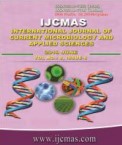


 National Academy of Agricultural Sciences (NAAS)
National Academy of Agricultural Sciences (NAAS)

|
PRINT ISSN : 2319-7692
Online ISSN : 2319-7706 Issues : 12 per year Publisher : Excellent Publishers Email : editorijcmas@gmail.com / submit@ijcmas.com Editor-in-chief: Dr.M.Prakash Index Copernicus ICV 2018: 95.39 NAAS RATING 2020: 5.38 |
A field experiment was carried out during kharif, 2015 in the Instructional cum Research (ICR) Farm of Assam Agricultural University, Jorhat, Assam (at a latitude of 26047' N, longitude of 94012' E and altitude of 87 m above mean sea level) with two cultivars of rice viz. Luit and TTB-404 grown in different micro climatic regimes created by manipulating the sowing as well as transplanting dates. Both the cultivars were sown on four different dates at fifteen days interval starting from 26 June, 2015 upto 10 August, 2015 following field layout factorial RBD. Agroclimatic indices viz., Growing Degree Day (GDD), Heliothermal Unit (HTU), Phenothermal Index (PTI) and Heat Use Efficiency (HUE) for attaining different phenological stages in both the cultivars were studied. Accumulated GDD at physiological maturity in different dates of sowing were relatively higher in TTB-404which varied from 2034.3oC to 2470.9oC, while in Luit it varied from 1685.4oC to 1928.1oC.With delay in sowing date, GDD accumulation till physiological maturity decreases in both the cultivars. Comparatively, in cv. Luit higher grain yield was recorded in the crop sown on D2 (11 July) and D3 (26 July), while in TTB-404 it was recorded in D2 (11 July) and yield in both the cultivars declines gradually with crop transplanted beyond first fortnight of August. Furthermore, the grain yield of both the cultivars was significantly correlated with accumulated GDD and HTU during transplanting to maximum tillering stage with correlation coefficients (r) 0.92** and 0.72* respectively.
 |
 |
 |
 |
 |